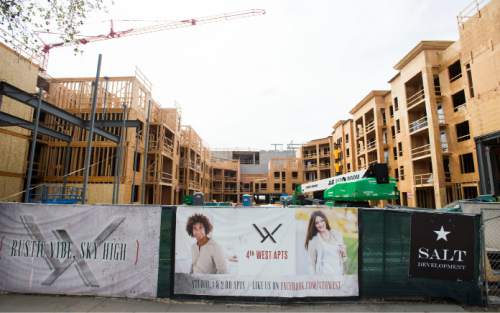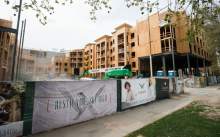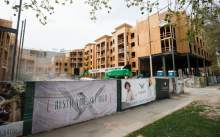This is an archived article that was published on sltrib.com in 2016, and information in the article may be outdated. It is provided only for personal research purposes and may not be reprinted.
Utah's renters are getting squeezed as monthly rents keep rising and incomes stay flat, new research shows.
Average rental rates in the state have climbed 17 percent in the past 10 years, adjusted for inflation, while median incomes for tenants grew a paltry 3 percent during the same decade, a top Utah economist says.
"We're in a period where we have declining affordability," said James A. Wood, an economic analyst and a senior fellow at the Kem C. Gardner Policy Institute at the University of Utah.
The trends are making rents less affordable in Utah and nationwide. New surveys also indicate that as house prices go up, market forces are leading large numbers of young adults to delay homebuying because they can't afford to save for a down payment.
More strikingly, researchers and housing advocates say, widening wage-rent gaps are steadily expanding the ranks of Utahns who are one financial emergency away from homelessness.
"They are living right on the edge," Wood said Friday. "A medical bill, a traffic accident or something else comes along they hadn't planned on and they end up with a serious threat of eviction."
Rising costs for labor, construction and land are key factors pushing up the price tags on apartment construction.
Wood recommends that Utah cities adopt more liberal municipal zoning policies to encourage higher-density multifamily housing construction to address the problem.
He pointed to new initiatives in Salt Lake City and Salt Lake County to encourage affordable housing and create new homeless-shelter space as "welcome, urgent and necessary."
Rental demand is high as the state's job market strengthens and its population swells. So far, though, a historic surge in apartment construction along the Wasatch Front shows little sign of significantly easing that rental crunch. Most multifamily dwellings being built are top end and command high-price rents.
Brigham City resident Chris Barber, 32, commutes two hours a day for his job in Murray because he cannot find an affordable place in the Salt Lake Valley.
"Every few months, I start looking again because I get tired of all that time in the car every day," Barber said. "But anything I look at is three times what I'm paying now."
Effects of the wage-rent pinch have been most pronounced for lower-income residents, according to Wood's research and other dataa.
Wage stagnation and rent hikes have pushed thousands of these residents across Salt Lake County and elsewhere into harsh territory as they spend increasingly burdensome portions of their pay on housing and face other difficult budget choices as a result.
Renters are considered "cost burdened" when they have to spend 30 percent or more of their monthly earnings on housing, utilities and related costs.
Those spending half their pay or more for home costs are defined as "severely cost burdened."
Eleven years ago, said Wood, about half of Salt Lake County's renter households earning between $20,000 and $34,999 a year were cost burdened. In 2014, that number had reached 80 percent, amounting to nearly 20,000 households.
"That is a big number," said Wood, who is the institute's Ivory-Boyer Real Estate Senior Fellow.
Rental markets in Utah County and statewide are on a similar path, he said, and the problem is likely to persist at least for the next few years.
A new poll of the Salt Lake City metro area by ApartmentList.com, aimed at young adults referred to as "millennials," found that nearly 90 percent of them want to buy homes, but 78 percent say they cannot afford them.
By comparison, 27 percent had delayed a home purchase because they were not ready to settle down, while 37 percent said they were waiting to be married.
Nearly 21 percent had delayed homebuying by two to three years as a result, while 58 percent had put the big-ticket purchase off for three years or more.
Based on their current monthly savings rate, the ApartmentList.com survey estimated, the average Salt Lake City millennial would need between 12.8 and 17.6 years to adequately save for a down payment.
Twitter: @TonySemerad









